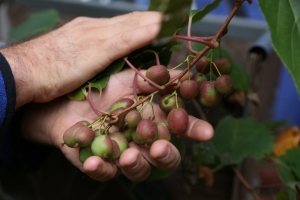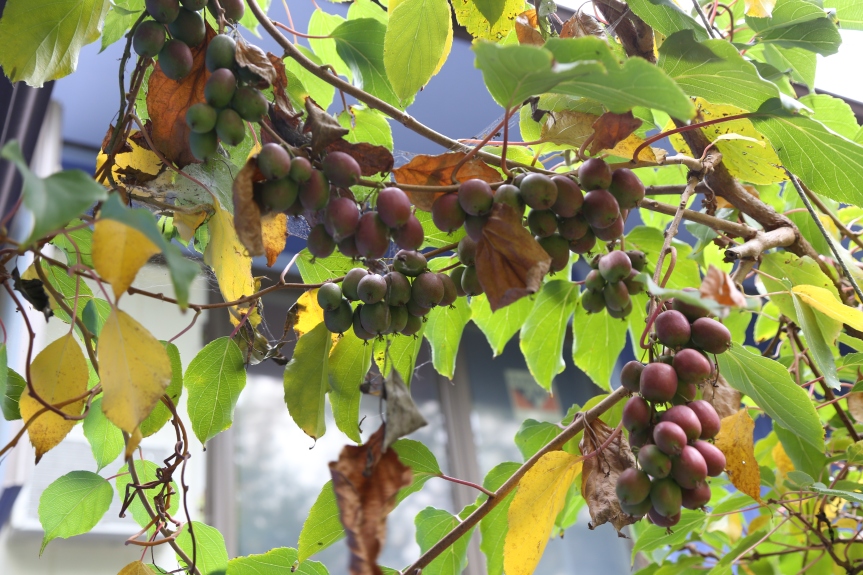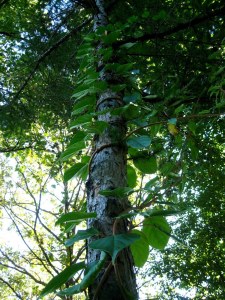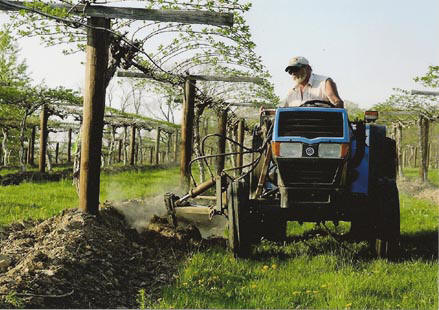
Hardy kiwi is a fruit that I’m just starting to become more acquainted with over the past few years— thanks to my generous/nutty friends and colleagues who kindly share their space and knowledge. Not to go on a tangent, but really its folks like Mike Levine, Ken Asmus, Marc Boone, and so many others who have made this path of fruit exploration so much more accessible for me as a young orchardist, and for that I’m very thankful. Anyways…Actinidia! Actinidia is the genus for kiwi, the fuzzy kiwi that we all know so well is A. deliciosa, but unknown to most are A. arguta and A. kolomkita, two kiwi species that are reportedly hardy to -25F. Hardy kiwi fruit however is approximately grape size and entirely fuzzless, unlike the supermarket kiwis most people know. So you can just pop ’em in your mouth whole, and their flavor is truly exquisite; many people, including myself, claim they have much better aromatics, sweetness, and overall flavor than the fuzzy kiwi. Out of all the uncommon fruits, like pawpaw, black currant, and jujube, to name a few— hardy kiwi seems like one that really has the potential to catch on and to be sought after by the likes of many, not just foody fruitnuts with crazy palates. One company, Kiwi Korners, has been successfully growing hardy kiwi as a commercial crop for some time now. None of my kiwi vines are producing yet, as they can take 5-10 years to come into bearing. DON’T WAIT, plant your kiwi vines today. Another reason I’m so adamant about hardy kiwi is how late they ripen in the season when not much else is available; from a resiliency and season extension standpoint this is prime. One minor challenge with kiwi vines in cold climates is their tender leaf buds want to unfurl very early and they’ll often get zapped by late spring frosts. This doesn’t kill the plant but it certainly sets it back for that season.

All In The Pruning…

Kiwis grow on vines, similar to grape vines. From my research and explorations thus far, it seems that the key to growing a productive hardy kiwi vine is all about proper training and pruning. Generally speaking, vining plants inherently want to just grow, grow, grow, and focus most of their energy into vegetative growth rather than flower and fruit development; so as caretakers of the vines there are certain ways we can coax the vines into instead thinking fruit, fruit, fruit. Its called spur pruning. Kiwi vines need annual pruning to develop small fruiting branches known as spurs. In my travels I’ve seen many large healthy looking kiwi vines, but often times their productivity is very low. Now I realize that these plants weren’t managed under a careful annual pruning regime. I am no expert in this field, or vineyard as it were, but I do know people that are so I’ll use this time to plug their expertise.



Mike Levine of Nature and Nurture, LLC has been growing hardy kiwi for several years in SE Michigan and he is one of the few people I know around here with such a successful system. Hats off to Mike for what he’s doing…
Another person who is perhaps one of the most experienced kiwi geeks in North America is Michael McConkey of Edible Landscaping in Afton, Virginia. Here Michael talks about summer spur pruning of kiwi vines…
Lee Reich is one of the upmost authorities on uncommon fruits and has a lot to say about hardy kiwi. Check out his book Uncommon Fruits for Every Garden to find more on hardy kiwi.

If you’re going to plant hardy kiwi(which everyone in the north should ASAP) it seems very worthwhile to take the time to train the vine to develop a single trunk system, and then manage the cordons each years to maximize their fruiting potential. I am so excited for the day that my vines come into production. There is oodles of information available on the web about hardy kiwi and the purpose of this post was to primarily talk about the training and pruning techniques necessary for growing productive vines. Visit the nursery links page to find sources for hardy kiwi plants. I’ll be busy dreaming of jars and jars full of kiwi raisins stored away for winter snacking…until next time!!






















